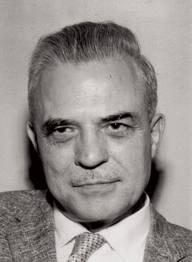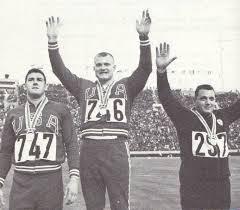I read Laura Miller’s brilliant continuation of Eleanor Catton’s article on literature and perceived elitism (after another twitter storm over the use of the word ‘crepuscular’ in the Paris Review) and in many ways felt I could not better their responses. Instead, I thought I’d tell a sort of parable of learning, whose implications you will easily work out for yourselves.

Erickson, looking worryingly like Robbie Williams’ granddad
In the first half the twentieth century, a psychotherapist called Milton Erickson had a gift for teaching people in strange and unusual ways. All Erickson’s patients wanted to do was something supposedly quite normal – lose weight, make love, travel without fear, or develop a new skill – but it was as if some kind of enchantment held them hopelessly in place. Bewitched by fear or insecurity, they lived lives of confinement, until Erickson and his bizarre methods succeeded again and again in releasing them from their spell. His therapies often looked contentious, but what he did have was insight into the obstacles we like to erect in the path of the learning process.
Erickson knew all about being stuck. As a teenager he had nearly died from an attack of polio that left him paralysed and mute. Using body memories and an unfeasible amount of determination, he re-learned how to access his muscles and eventually regained control of his speech and his arms. Dissatisfied still that he could not use his legs, he decided to embark, alone, on a thousand-mile canoe trip, taking with him only a few dollars. He returned home able to walk with the help of a cane, the ordeal having taught him how to push himself beyond what he believed to be his physical, mental and emotional capacities. These experiences restored his body to him, but they also gave him much insight into the complicated process of getting people to learn things to which they have an inbuilt resistance. He knew that minds are bewitched by the magician’s sleight of hand and powerfully affected by the experience of an ordeal, and he made use of these different mental triggers in his therapeutic process with great cunning and invention.
He was particularly successful at treating sportsmen who were struggling to reach new levels of achievement. One of his case histories concerns a young American high school boy who won a gold medal at the Olympics under his tutelage. When Erickson first met Donald Lawrence, he had been practicing the shot put for a year and theoretically had everything going for him. He was six foot six, 260 pounds of pure muscle and trained by an ambitious coach. But he was still significantly short of attaining a national high school record. Erickson told him the story of how Roger Bannister found the right frame of mind to break the four-minute mile by recognizing that he only needed to shave a tenth of a second off the previous record. He said to Lawrence, ‘You have already thrown the shot fifty-eight feet. And Donald, tell me honestly, do you think you know the difference between fifty-eight feet and fifty-eight feet and one-sixteenth of an inch?’
Over the next few sessions, Erickson would repeat this technique, lingering over the hard to conceptualise difference between fifty-eight and fifty-nine feet on an athletic field, or as he put it, enlarging the possibility for the young man. Two weeks later, Lawrence set a national high-school record.

Lawrence wins his Olympic bronze medal
Having proven himself to be a magician, Erickson had the boy in the palm of his hand. A few months later, he came to Erickson for advice about the Olympics. ‘You are just an eighteen-year-old kid,’ Erickson told him. ‘It would be all right if you bring home the bronze medal.’ Which Lawrence promptly did. Four years later, Erickson advised him that it would be fine for him now to win gold. By the time he stopped working with him, Lawrence was throwing the shot put sixty-eight feet and ten inches, all on the basis of a potent cocktail of numerical confusion, self-belief and a dogged devotion to the magic of authority.
Erickson’s success was based on the recognition that the conscious mind has really very little say in what we actually end up doing. All those motivational talks, all that pumping oneself up, all that pleading and scolding that goes on inside our heads is so much white noise. What’s actually in control is a small, piggy part of the self, stubborn, well-defended and unwilling to budge. Erickson’s methods depended on implementing change by tiny, tiny increments. The natural inclination is to rush towards change, trying to attempt far too much in one go and ensuring failure. Instead, he encouraged his patients to consider how to make a two percent change to their situation. It had to be something negligible, something almost ludicrous in order to evade all those internal censors, hell-bent on assuring continuity. For once a little change has been made, change itself became a more acceptable concept, and another step in the right direction would be much easier to undertake.
But aligned with this insight was Erickson’s covert use of authority. Authority is generally what most of us appeal to in order to get the piggy part moving. Do it, or else, is the classic default setting for action. But Erickson’s authority was benign when he worked with Lawrence. Erickson was known as a shrewd judge of character, quick to exploit a patient’s foibles, and when he saw the docile, hard-working Lawrence steered into his consulting rooms by a determined coach with his eye on high school glory, he must have recognized a personality that would readily and willingly submit.
A relationship to authority resides at the heart of any learning process. The fear of the teacher’s wrath, the fear of the exam, the fear of public humiliation are undoubtedly motivating factors. But the stick isn’t enough on its own – there must be a carrot too. And the flip side of authority, its gentle alter ego, is the act of belonging. We submit to education in the first place in order to belong to our world, to a particular culture or society and its ways of thought. Belonging is a hidden, stealthy part of the things we learn, but it is all the more powerful for being understated. The young shot-putter belonged entirely to Erickson, as his faithful and loyal disciple. The sheer power of that belonging gave him the confidence to do whatever it was that Erickson said he could do.
For most of us, the point of thinking is to reach a point where we don’t have to think any more. A point where our ideas are organised, fixed and justified. And that point is usually one that is terrifically satisfying in relation to belonging – our ideas please our parents or our teachers, they seem in line with the famous figures we admire, the class we aspire to, the religion or political party that impresses us. It’s why intellectual arguments, no matter how brilliant they are, rarely persuade people to think otherwise, even in situations where objective, rational arguments might be recognized as extremely valuable. We have already thought ourselves into a position that feels secure and correct. To have to move on from it, to undermine all we have learnt to master, to face challenges, new ordeals, opposing thoughts, well, it’s no wonder that it’s a ghastly, unnerving prospect for anyone.
Erickson showed how knowledge is not just an acquisition based on logic, but one fraught with emotion and the need for security. We become emotionally attached to what we think we know, and so the greater the change in our knowledge, the more emotionally challenging it feels.
